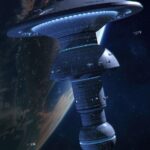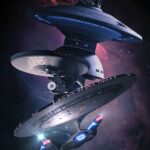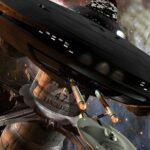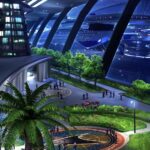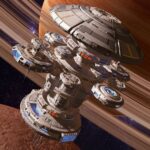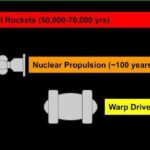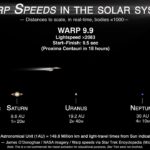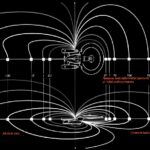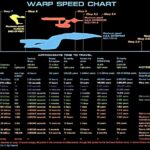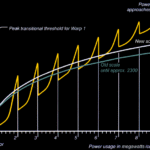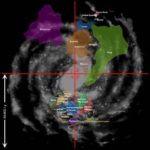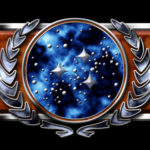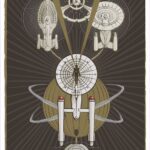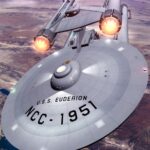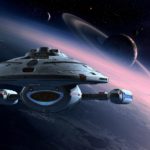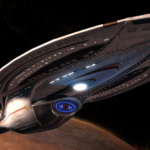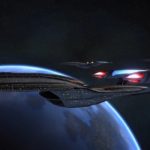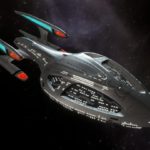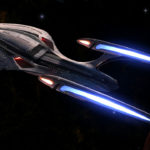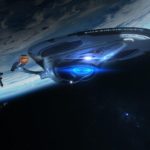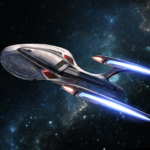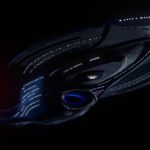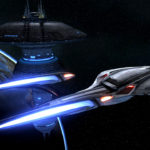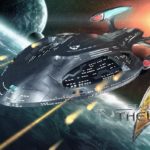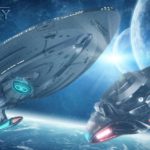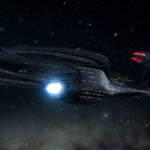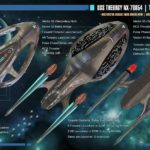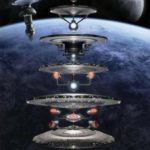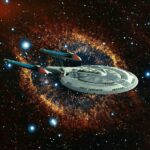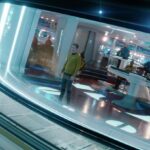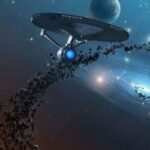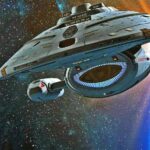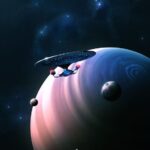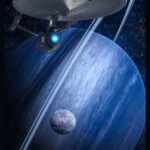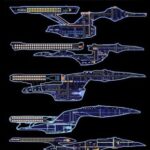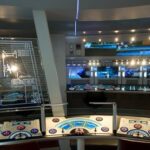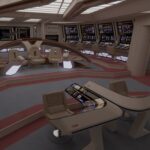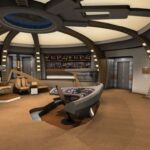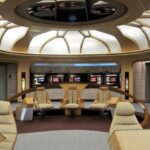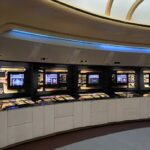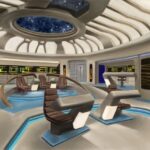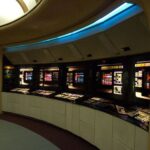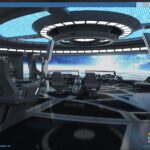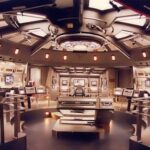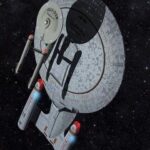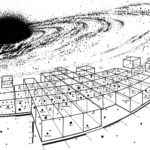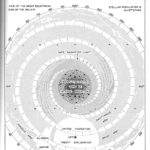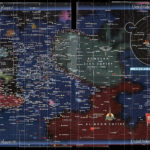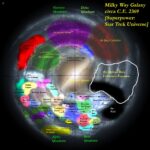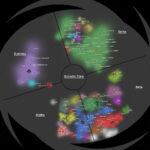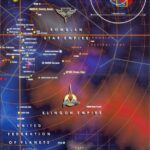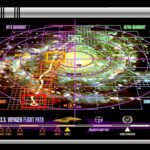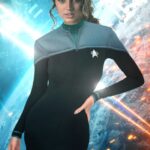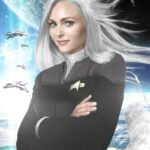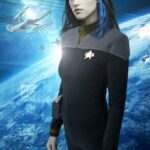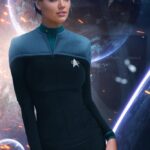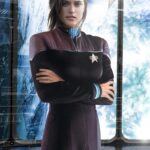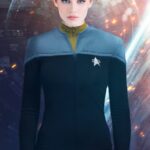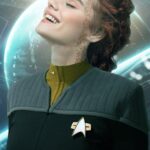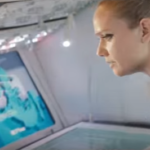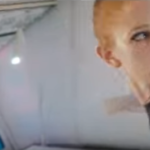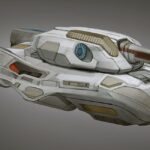This is what NASA became; America’s Secret Space Program (SSP) includes Starfleet. Details here.
–
Table of Contents:
- Introduction
- History
- Species Represented
- Organization
- Uniforms
- Bases/Installations
- Vessels
- General Orders and Regulations
- Scale Over Time
- Inertial Dampeners
- Warp Tears
- The .01% Who Gets to Meet Auz
- Emblems (Images Begin)
- Starship Exteriors
- Starship Cross-sections
- Starship Interiors
- Starship Comparisons
- Starfleet Maps
- Starfleet Hotties
- Ground Vehicles
- 2023 September/+
–
Introduction:
Starfleet was the deep space exploratory and defense service maintained by the United Federation of Planets. Its principal functions included the advancement of Federation knowledge about the galaxy and its inhabitants, the advancement of Federation science and technology, the defense of the Federation, and the facilitation of Federation diplomacy.
As per its mandate of deep space exploration, its personnel were frequently brought into contact with cultures and sentient species whose existences were unknown to the Federation. Starfleet officers therefore acted as official representatives of the Federation in these cases. Starfleet vessels were also frequently used to ferry ambassadors on diplomatic missions. (TNG: “The Last Outpost“, “Conspiracy“; VOY: “Innocence“, “The Void“; TOS: “Journey to Babel“; Star Trek)
Just like how the TV show M*A*S*H was made to help Vietnam veterans ‘decompress’ after their service/enlistments, shows such as Star Trek were made to help SSP veterans decompress; it showed them something relatable and special, and laced with a hearty amount of all the emotions, including humor, easing them back into civilian life and positive mindsets.
–
History of Starfleet:

United Earth Starfleet Flag (22nd century)
Prior to 2161, Starfleet was the primary space exploration organization of United Earth in the early-to-mid 22nd century. The primary authority of Starfleet was referred to as either Starfleet Command or the United Earth Space Probe Agency(UESPA), and was located at Starfleet Headquarters in the city of San Francisco, Earth. (ENT: “Broken Bow“, “Terra Prime“)
–
While UESPA already existed in the 2060s according to VOY: “Friendship One“, Starfleet was presumably founded in the mid-2130s, as Jonathan Archer gave some thought to join the Earth Cargo Service a few years before Starfleet was chartered, and 2134 was his senior year in college. Starfleet must have existed in 2136, as Margaret Mullin turned down Archer’s proposal of marriage, since she did not want to become a “Starfleet widow.” (ENT: “Vox Sola“, “Horizon“, “Twilight“) Furthermore, the series bible for Star Trek: Enterprise referred to the organization as having been in existence for “less than twenty years” prior to 2151. The possibility that the organization was even younger than this was entertained, though. In retrospect of having co-created the series, Brannon Braga commented about Starfleet, “It’s only been around for a decade or more [as of 2151].” (Broken Bow, paperback ed., p. 250)
–
The primary purpose of Starfleet from its infancy was to “…seek out new life and new civilizations,” and “…go boldly where no man has gone before.” (This quote is attributed to Zefram Cochrane, the inventor of warp drive on Earth.) (ENT: “Broken Bow“)
Some Starfleet personnel worked in conjunction with the United Earth Diplomatic Corps.(ENT: “The Forge“)
For a time, beginning in 2153, some Starfleet vessels began carrying detachments of MACOs, an Earth military service. This practice was a reaction to the devastating Xindi attack on Earth, and subsequent mission into the Delphic Expanse in response. The decision to carry these units was left up to individual starship captains, and was not a formal policy of Starfleet Command at the time. While Enterprise NX-01 had MACO units assigned to its mission as late as 2161, it is unknown whether its sister ship, Columbia, ever had a contingent attached to it. (ENT: “The Expanse“, “Home“, “These Are the Voyages…“)
One of the primary projects of Starfleet was to develop a viable and fast interstellar engine that would allow Earth to practically cross vast distances in reasonably short time. Despite some allegations of interference – or at least, a refusal of assistance – from the Vulcans, Earth had made notable progress in developing the warp five engine by the 2150s. (ENT: “Broken Bow“)
–
Article 14, Section 31, of the original U.E. Starfleet Charter made allowances for certain rules to be bent during times of extraordinary threat. This clause was the seed for the rogue organization known as Section 31. Lieutenant Malcolm Reed was recruited to Section 31 as a young ensign. (ENT: “Affliction“, “Divergence“; DS9: “Inquisition“)
–
United Federation of Planets Starfleet:
With the formation of the Federation in 2161, as per the Federation Charter, United Earth Starfleet, MACO and the deep space and defensive services of the other member worlds were folded into the authority of the Federation. (DS9: “Inquisition“; ENT: “Detained“, “Divergence“; Star Trek Beyond)
Until as late as the 2290s, some Starfleet operations continued to fall at least partly under the jurisdiction of UESPA. By the mid-24th century, however, Starfleet operations were regulated solely by Starfleet Command, answering to the Federation President and the Federation Council. (TOS: “Charlie X“, “Tomorrow is Yesterday“; Star Trek IV: The Voyage Home; et al.)
–
Species with representatives in Starfleet:

Many Starfleet members of various species
Starfleet has always been a multiracial organization, composed of species from various worlds. Even though Starfleet was an organization representing United Earth and later on the United Federation of Planets, it was not a requirement for Starfleet personnel to be Human, or later on, from a member species of the Federation. (ENT: “Broken Bow“; TNG: “The Chase“)
As an example, in 2369, there were 17 representatives from non-Federation planets serving on the USS Enterprise-D. (TNG: “The Chase“) At times Starfleet has even allowed members from species that were its enemies at the time to work as crew members, including Worf during the Federation-Klingon war of the 2370s, part-Romulan Simon Tarses and Seven of Nine, a Borg. (DS9: “The Way of the Warrior“; TNG: “The Drumhead“; VOY: “Scorpion, Part II“)
The following races have had members of their species working for Starfleet:
- Abdon’s species (DS9: “The Assignment“)
- Airiam‘s species (DIS: “Context Is for Kings“)
- The species of the alien officer on USS Enterprise (Star Trek III: The Search for Spock)
- The species of the alien officer on USS Enterprise-D (TNG: “Data’s Day“)
- The species of another alien officer on USS Enterprise-D (TNG: “In Theory“)
- The species of the alien doctor on USS Kelvin (Star Trek)
- The species of the alien helmsman on USS Relativity (VOY: “Relativity“)
- The species of the alien officer on USS Shenzhou (DIS: “The Vulcan Hello“)
- Alnschloss K’Bentayr‘s species (Star Trek)
- Andorians (Star Trek IV: The Voyage Home)
- Android, the Soong-type android Data (TNG: “Encounter at Farpoint“)
- Arcturians (Star Trek: The Motion Picture)
- Argosians (DS9: “Dax“)
- Arkenites (Star Trek IV: The Voyage Home)
- Bajorans (TNG: “Ensign Ro“)
- Benzites (DS9: “The Ship“)
- Betazoids (TNG: “Encounter at Farpoint“)
- Betelgeusians (Star Trek: The Motion Picture)
- Bolians (TNG: “Conspiracy“)
- Boslics (DS9: “Call to Arms“)
- Caitians (Star Trek IV: The Voyage Home)
- Deltans (Star Trek: The Motion Picture)
- Denobulans (ENT: “Broken Bow“)
- Edosians (TAS: “One of Our Planets Is Missing“)
- Efrosians (Star Trek IV: The Voyage Home)
- Elaysians (DS9: “Melora“)
- Ferengi (DS9: “Heart of Stone“)
- Haliians (TNG: “Aquiel“)
- Humans (TOS: “The Cage“)
- Kelpiens (DIS: “The Vulcan Hello“)
- Klingons (TNG: “Encounter at Farpoint“)
- K’normians (Star Trek: The Motion Picture)
- Megazoids (Star Trek VI: The Undiscovered Country)
- Napeans (TNG: “Eye of the Beholder“)
- Nara’s species (TNG: “Eye of the Beholder“)
- Pardshay’s species (Star Trek VI: The Undiscovered Country)
- Peliar Zel natives (TNG: “The First Duty“)
- Rhaandarites (Star Trek: The Motion Picture)
- Romulan/Human, Simon Tarses (TNG: “The Drumhead“)
- Saurians (Star Trek: The Motion Picture)
- Tellarites (DS9: “Apocalypse Rising“)
- Tiburonians (DS9: “The Ship“)
- Trill (DS9: “Emissary“)
- Tyrellians (TNG: “Starship Mine“)
- Vilix’pran’s species (DS9: “Heart of Stone“)
- Vulcans (TOS: “The Immunity Syndrome“)
- Worene’s species (Star Trek: The Motion Picture)
- Zakdorn (TNG: “Unification I“)
- Zaldans (TNG: “Coming of Age“)
- Zaranites (Star Trek: The Motion Picture)
In addition, the Arkarians provided baryon sweeps for Starfleet starships, and Bynars provided their services in upgrading the computers of Starfleet ships. (TNG: “11001001“, “Starship Mine“) Starfleet also employed sentient artificial photonic lifeforms as holographic emergency personnel, such as the Emergency Medical Holographic programs. The El-Aurian Guinan provided her services as bartender on the Enterprise-D and the Talaxian Neelix, the Ocampa Kes, the Borg Seven of Nine and the Brunali former Borg drone Icheb worked as members of the crew of the USS Voyager during the voyage through the Delta Quadrant. (TNG: “The Child“; VOY: “Caretaker“, “Scorpion, Part II“, “Imperfection“)
–
Organization:
Direct commanding authority over Starfleet was a power of the Federation President. (DS9: “Homefront“, “Paradise Lost“, “Extreme Measures“, Star Trek VI: The Undiscovered Country) In addition, the Federation Council, the Federation’s legislature, often directly influenced the service’s operations and even issued orders on occasion. (TNG: “Force of Nature“, “The Defector“) The day-to-day operations of the service were managed by Starfleet Command, under a commander in chief. (Star Trek VI: The Undiscovered Country)
Commander in Chief:
The commander in chief oversaw the operations of the entire service, and reported directly to the Federation president. (Star Trek VI: The Undiscovered Country) In the late 2370s, the position of commander in chief was actually held by Federation President Jaresh-Inyo. (DS9: “Paradise Lost“)
Starfleet Command:
This was the service’s operational authority. Senior positions included the Commander, Starfleet, the chief of staff and the chief of Starfleet Operations. (Star Trek III: The Search for Spock; Star Trek IV: The Voyage Home; Star Trek V: The Final Frontier)
Sector Commands:
These oversaw operations of the service within sectors of Federation space. There were at least 23 sector commands. Sector commanders reported to Starfleet Command, and commanding officers of service vessels operating within these sectors reported to them. (TNG: “Power Play“, “The Measure Of A Man“)
Starfleet Academy:
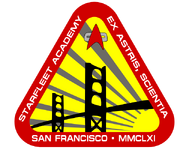
Starfleet Academy seal
Starfleet Academy was a facility maintained by the service for the training of its officers. Prospective officers received extensive training at this facility, for a period of four years. Undergraduates attending the facility were called midshipmen in the 23rd century and cadets in the 24th century. Successful graduates were commissioned as Federation Starfleet officers.
Branches and Agencies:
There were a number of branches and agencies that assisted Starfleet Command in the running of the service.
- Judge Advocate General
- Office of the Inspector General
- Spaceframe Development
- Starfleet Administration
- Starfleet Advanced Technologies
- Starfleet Bureau of Information
- Starfleet Cartography
- Starfleet Corps of Engineers
- Starfleet Exploratory Division
- Starfleet Intelligence
- Starfleet Materiel Supply Command
- Starfleet Medical
- Starfleet Mission Operations
- Starfleet Operational Support Services
- Starfleet Operations
- Starfleet Orbital Operations
- Starfleet Research and Development
- Starfleet Shipyards Operations
- Starfleet Security
- Starfleet Science
- Starfleet Stellar Imaging
- Starfleet Tactical
–
Personnel:
Starfleet personnel were organized, using a naval-derived rank structure, into a chain of command. Personnel were in either of two groups: enlisted personnel and officers. Some personnel formally committed to the service by taking the Starfleet oath.
Officers:
In the 22nd century, Starfleet was a civilian organization acting as a successor to various Earth based space agencies such as NASA, the International Space Agency, and others. Its primary function was scientific development and exploration of space.
Starfleet officers functioned as commanders and directors of the service’s operations at all levels. The most senior officers ranks were known as flag officer ranks. Officers holding these ranks functioned at the highest levels of command in the service. Flag officer ranks, in descending order of the chain of command, are as follows:
- Fleet Admiral
- Admiral
- Vice Admiral
- Rear Admiral
- Commodore/Rear Admiral, lower half
Sector commanders, the Superintendent of Starfleet Academy, the Commander, Starfleet, the Starfleet Chief of Staff and Chief of Starfleet Operations, and the Commander in Chief, were all flag officers. (Star Trek III: The Search for Spock; TNG: “Ménage à Troi“, “The First Duty“)
Below flag officer ranks were other officer ranks. Officers holding these ranks usually served in field command positions, such as commanding officers and senior staff on the service’s vessels. These ranks, in descending order of the chain of command, were as follows:
Graduates of Starfleet Academy were commissioned to the rank of ensign, the most junior officer’s rank, and were promoted to higher ranks over the courses of their time in the service. Physicians who graduated from Starfleet Medical Academy in the 24th century were commissioned to the rank of lieutenant junior grade.
Enlisted personnel:
These personnel functioned under the command of the officers, usually serving aboard Starfleet vessels or other facilities. Instead of officers’ training, enlisted personnel received basic training for whatever position they served in. (VOY: “Good Shepherd“, et al.) The most junior enlisted rank was that of crewman. The service’s enlisted rank structure, in descending order of the chain of command, was as follows:
- Master chief petty officer
- Senior chief petty officer
- Chief petty officer
- Petty officer
- 1st class
- 2nd class
- 3rd class
- Crewman
The enlisted ranks above that of crewman were not commissioned officer ranks. To distinguish them from commissioned officer ranks, the term ‘non-commissioned officer‘ was used. All enlisted personnel were subordinate to commissioned officers in the chain of command.
Uniforms:
In the 22nd century, the same basic uniform was worn by all Starfleet officers, with differences in insignia and color-coded elements designed to distinguish rank and departmental function. Starfleet departments included Starfleet Operations and Starfleet Security. (ENT: “Broken Bow“)
Starfleet personnel wore distinctive uniforms while on duty. These uniforms generally displayed the department color of the department/division the enlisted person or officer served in, and also the rank insignia.
Wearing a Starfleet uniform when not actually a member of Starfleet would put one at risk of being charged with impersonating a Starfleet officer. (DS9: “Chrysalis“)
–
Bases and Installations:
Aside from its headquarters, located on Earth, the Federation’s capital world, Starfleet also maintained installations throughout Federation territory.
Star-bases / Space Stations:

Starbases, facilities for resupply of the service’s vessels and the relaxation of vessel crews, were maintained in all sectors of Federation space. In addition, the service also maintained facilities beyond Federation territory. The most well-known of these is Deep Space 9, in the Alpha Quadrant. (Star Trek: Deep Space Nine)
Shipyards:

The Utopia Planitia Fleet Yards
The service also maintained a number of shipyards at which it constructed its vessels and designed and tested new vessels and vessel types. Among the most famous of these shipyards were:
- The Utopia Planitia Fleet Yards, located in orbit around Mars
- The San Francisco Fleet Yards, located in orbit around Earth
- The Beta Antares Ship Yards, located in the Antares sector
(TNG: “Parallels“, “Eye of the Beholder“, “Night Terrors“, “The Wounded“; Star Trek: The Motion Picture; VOY: “Message in a Bottle“)
Training Facilities:
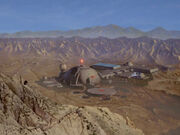
Relva VII testing facility
Apart from Starfleet Academy, the service also maintained several training facilities for both officers and enlisted personnel. These included a number of Academy annexes, located in different systems. Known annexes were Starfleet Academy (Beta Aquilae II), Starfleet Academy (Beta Ursae Minor II) and Starfleet Academy (Psi Upsilon III). (TNG: “Eye of the Beholder“) The service also maintained at least one testing facility to evaluate prospective Starfleet Academy undergraduates for admission into the academy. This facility was located on the planet Relva VII. (TNG: “Coming of Age“)
Starfleet Academy also had a training program for enlisted personnel. (TNG: “The Drumhead“; DS9: “Trials and Tribble-ations“) In addition at least one other such facility was located on Mars, known as the Starfleet Technical Services Academy. (TNG: “Eye of the Beholder“)
–
Vessels:
The single most important asset that Starfleet possessed, apart from its personnel, was its vast number of vessels.
Starships:
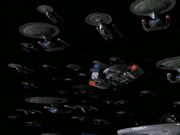
A task force of Starfleet starships prepares for battle
The backbone of Starfleet’s operations were its starships. These vessels, all warp-capable, were capable of supporting and providing the ability and resources to carry out all of the service’s mandates: exploration, the defense of the Federation, the transport of supplies and resources, and providing emergency medical care. A large range of starship classes existed. Some were multi-purpose and other were designed for a specific use. By the 24th century, Starfleet’s mandates stated that no warships, or ships designed purely for defensive purposes, would be built, but an exception was made when the threat of the Dominion became evident.
The most famous ship of pre-Federation Starfleet was the NX-class Enterprise NX-01. That ship was the first to be equipped with the Warp 5 engine, and made first contact with over thirty species. Under the command of Captain Jonathan Archer, Enterprise established Earth as an interstellar power after negotiating treaties between the Vulcans and Andorians in 2152, saving the galaxy from the Sphere-Builders and the Xindi in 2154, uncovering the lost teachings of Surak on Vulcan and preventing a Vulcan invasion of Andoria later in 2154, helping to instigate a cultural and political coup d’état against the dictatorial Vulcan head of state Administrator V’Las, and facilitating peace talks between the Andorians and Tellarites following a series of attacks on both races in late 2154. (ENT: “Broken Bow“, “Cease Fire“, “Zero Hour“, “The Forge“, “Awakening“, “Kir’Shara“, “Babel One“)
The United Earth Starfleet also built the NX-class Columbia, launching that ship in late 2154, with at least two more NX-class ships planned. (ENT: “Fortunate Son“, “Home“, “Affliction“)
The United Earth Starfleet did not have any jurisdiction over what happens aboard vessels operating in the Earth Cargo Service. That responsibility remained in the hands of the Earth Cargo Authority. (ENT: “Fortunate Son“, “Horizon“)
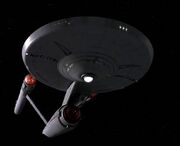
Constitution-class
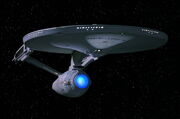
Constitution-class refit
The Constitution-class was historically one of the service’s most important starship classes. Starships of this class were the service’s frontline vessels in the 23rd century, designed for long-term exploratory missions lasting five Earth years. The most storied of these vessels was the USS Enterprise under the command of Captain James Tiberius Kirk. During his historic tour of duty as captain, countless new civilizations, planets, and anomalies were studied. (Star Trek: The Original Series; Star Trek: The Motion Picture)
In the late 2260s to early 2270s, the Constitution-class starships underwent a major refit program. The actual refitting took eighteen months of work and essentially a new vessel was built onto the bones of the old, replacing virtually every major system. These upgraded refit Constitutions provided a bridge in capability until the next class of modern Starfleet cruiser could take their place at the forefront of galactic exploration, diplomacy, and conflict. Thus, the Constitution-class continued in service for a further twenty years.

Excelsior-class
The Excelsior-class was initially constructed during the early 2280s at Starfleet’s San Francisco Fleet Yards orbiting Earth. (Star Trek VI: The Undiscovered Country dedication plaque) Starfleet had high hopes for the first ship of this class, the prototype USS Excelsior, which was equipped with transwarp drive, and was regarded as that century’s “Great Experiment.” (Star Trek III: The Search for Spock) Despite the failure of the “Great Experiment,” Starfleet forged ahead with employing the Excelsior design. After remaining in Earth Spacedock until at least 2287, the prototype Excelsior was subsequently recommissioned for active service by 2290. In 2293, the Excelsior design was given greater notoriety when Starfleet passed on the name of a legacy. The launch of the USS Enterprise-B opened the door for the Excelsior class to become one of the most widely used designs in all of Starfleet, a design lasting well into the late 24th century. (Star Trek VI: The Undiscovered Country; Star Trek Generations; TNG: “Encounter at Farpoint” – VOY: “Endgame“)
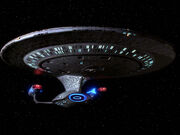
Galaxy-class
In the 24th century, the Excelsior design was gradually replaced as the service’s front-line vessel class by the Galaxy-class. Primarily designed at the Utopia Planitia Fleet Yards, this class was the most technologically sophisticated in the history of the service. (TNG: “Lonely Among Us“, “Contagion“) Vessels of this class were the largest in size of any ever produced in Federation history, and became well-known, both within and outside of the Federation, for their capabilities in both scientific enquiry and exploration. (TNG: “Tin Man“, “Chain of Command, Part I“; DS9: “Valiant“) The most recognized vessel of this class was the USS Enterprise-D, commanded by Captain Jean-Luc Picard. (Star Trek: The Next Generation)

Sovereign class
Due to continual advancements in design, the Galaxy-class was eventually replaced by the Sovereign-class. This class featured innovations in weapons, warp propulsion and computer processing power. The most noteworthy vessel in this class was the USS Enterprise-E, again commanded by Captain Jean-Luc Picard. (Star Trek: First Contact)
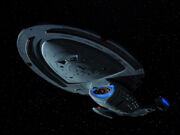
Intrepid-class
Another very well known class was the Intrepid-class. This class was older than the Sovereign-class, but more advanced than the Galaxy-class. The Intrepid-class proved itself many times beyond what was expected of it when a ship of this class, the USS Voyager, commanded by Captain Kathryn Janeway, was cast nearly 70,000 light years away from Federation space, deep into the unexplored Delta Quadrant, in 2371. The ship supported Captain Janeway and her crew through dangers never before encountered by a Starfleet crew, and successfully returned to Federation space in 2378. For those seven years, the ship had no access to any kind of Starfleet supplies or maintenance whatsoever. (Star Trek: Voyager)
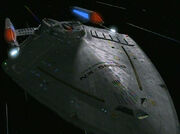
Prometheus-class
Other noteworthy starship classes were the Akira-class, the Nova-class, the Olympic-class, the Defiant-class and the experimental Prometheus-class. The Defiant– and Prometheus-classes were primarily designed for tactical operations. (DS9: “The Search, Part I“; VOY: “Message in a Bottle“) The Olympic-class was designed as mobile emergency medical centers. (DS9: “Sacrifice of Angels“, “In the Pale Moonlight“, “Image in the Sand“, “The Siege of AR-558“, “What You Leave Behind“; TNG: “All Good Things…“)
Starfleet starships had navigational lights, red on the port (left) and green on the starboard (right), fitted to the hull. Such has been seen on vessels from the late 2100s through to the late 2300s. (Star Trek: Enterprise; Star Trek VI: The Undiscovered Country, Star Trek Generations, Star Trek Nemesis)
Other vessels:
Aside from its starships, the service also operated other vessels. Among these were several types of shuttlecraft, which were typically used to transport personnel over relatively short distances, such as from a starship orbiting a planet down to the planet’s surface. (ENT: “Chosen Realm“, et al.)
Starfleet shuttlecraft of the 23rd and 24th centuries also were equipped with limited warp capability, allowing transport of personnel within a range of several light years from the starship. (VOY: “Initiations“, “Tsunkatse“, “Good Shepherd“)
Time vessels:
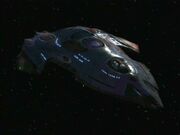
The Wells-class
Interventions by Starfleet of the 29th century into the 24th century revealed vessels that the service used in that time. In this century, Starfleet had yet another mandate: to safeguard the timeline. Thus it operated vessels that were able to routinely traverse through time. These vessels were called timeships.
Classes of these vessels included the Wells-class and the Aeon-type.
…
For reference, the warp-speeds numbers-system is explained here.
–
General Orders and Regulations:
The service maintained a set of regulations, known as Starfleet General Orders and Regulations. These governed all aspects of service operations and covered all possible situations it was thought that personnel might encounter, from protocol to situations of First Contact with unknown species.
The most important of these was termed General Order Number One, but was more commonly referred to as the Prime Directive.
Not all of the general orders and regulations were intended for general personnel knowledge. At least one, known as the Omega Directive, was a top secret of the highest order, and was known only to officers ranking captain or any flag officer rank. This was due to the extreme sensitivity and danger posed by the subject the directive dealt with. (VOY: “The Omega Directive“)
–
Scale Over Time:
The events featured in the “soft disclosure” television shows centered around milestones of Starfleet are said to span an era from ~2100 to ~2400 A.D. (though the plot jumps from the 2100s setting of the first show in the series… more than two centuries, when Next Generation is set), starting with the first Naval Construction Contract (NCC) for one of the featured starship-classes (types). For three+ centuries, it is said/televised, people from Earth were going into Space, meeting people from other worlds, and forming partnerships and friendships with them, sometimes even marrying.
Here are a few notes on how the ships, ship types, crews, and species of Starfleet changed during those years:
- Secret Space Program (SSP) ships, as part of Solar Warden and other SSPs, are said to have been built and flown across Space as early as the late 1800s, and are largely still-classified, their numbers, classes (ship types), and crews (perhaps forever) undisclosed. It was these ships and missions that eventually led to the semi-public portion of the ongoing Space program/s; Starfleet. (“Semi-public”, because “soft disclosure” was still an OPSEC-based necessity; the work out there was so important, expensive, and at-risk, not to mention controversial in many ways.)
- There was only 1 class of starship at the start of all that, then up to ~15 at maximum fleet-size centuries later.
- ~10,000 ships at maximum fleet-size in the 2300s, fluctuating by ~1,000 after big battles / heavy losses
- Ships like the first version of the Enterprise had a crew of ~430, while later variants had a crew of 1,000/+.
- Originally, there were only humans in Starfleet, as it was started on Earth prior to disclosed contact. Over the three centuries Starfleet operated, eventually ~150 humanoid alien species started having membership in it.
- What is never shown in any of the shows/films is that in 2313, while Captain Picard was still commanding the Stargazer (before he was assigned to the Enterprise), the portion of Starfleet on, and in orbit around/near, the Earth… was involved in a massive unexpected global-population evacuation campaign that took heavy losses of both personnel and starships; this was the year when all the returned/restored/manifested dragons of King Auz were unleashed, having grown fed-up with humanity repeating all the mistakes which King Auz had been forced to endure and invent ingenious solutions for back in the 2000s. The event was so emotionally-scarring for the survivors, including the members of Starfleet at the time, that SSP/MIB memory-adjusting technology was used make them all forget it, those who’d had homes/families on the Earth… convinced that the Earth-like colony-planet they were then returning “home” to… was the original/actual/previous Earth they’d really known. Most of Starfleet was faraway during that global dragon-managed humanity-deportation/eviction, so The Federation easily lived on out there, but all who dared defy King Auz’s order to leave the Earth once and for all… met shockingly-swift and vicious ends when the dragons, all of whom were far more powerful than any of the humans’ starships, took to the skies and started burning and clawing all the stragglers to death. Ever since 2313, no Starfleet ship or human has been allowed back, or lived to tell the tale of trying, except those exceptional few who are compatible with The Inisfreean Way, thus sometimes permitted as representatives who still never get to stay/recolonize. (Captain Picard was far out in Space on missions with Stargazer during this time, and never learned the truth, always convinced that the world he returned to after that… was the real Earth.)
- After the 2400s, Starfleet slowly morphed into the fleets featured in StarCraft, Halo, EVE Online (New Eden), Warhammer, and so on. Never after the early 2400s was “Starfleet” used to reference the fleets of starships humans were using; the term fell into disuse as new fleets, fleet names, and terms were deemed more fitting. Many millennia after all those, there also came the fleets of “The Human Empire”, which came to be ruled by Goddess-queen Aorlie, though people then did not need starships anymore to travel the distances between the worlds –which King Auz and his alliance of goddesses had, by then, by the way, been wielding and willing to move back closer like all worlds were in the First Time.
Speculation on greater specificity can be found here, here, here, here, here, and here.
The official timeline of all the events/episodes/series is here.
–
Warping vs. Teleporting:
Why is it that the ships get warped through Space, but people get beamed up? Why not warp people aboard, too? Seems to me if they had the power to warp a million-ton starship, they could warp a .075 ton (150 lb.) crew member. Is it that the hull and shield of their ships protect them from the warp field, and a smaller warp field might stretch or radiate a person?
It turns out that an antimatter reaction is the basis of their nacelles bending Space, allowing their ships to cross cosmic distances much faster than any other form of propulsion known to them would allow. Those reaction come with an extreme amount of radiation, and it takes their ships to protect them from that. That radiation/heat also has to be vented, otherwise their engines would overheat/melt/explode, and that is where the cold void of Space comes in; that is why their nacelles are as far away from the rest of their ships as possible.
Teleporting is controversial, because they way they do it in Starfleet… is said to be like sending a fax; the original document stays there (to be used as ‘slush matter’/particles to recreate/’print’/form whomever is teleported back to that given transporter room, …while only the information about how their body was formed… gets transmitted like a radio signal to the destination transporter-room, where an identical matter/particles-‘tank’ feeds a stream of needed elements/materials in over the transporter spots… to be formed into the exact body (memories and all) that was de-atomized/transmitted moments before. Does this mean their mind/’soul’ is somewhere else, and automatically reenters any body that it was used to being in, regardless of distance traveled/beamed? Some say you die every time you are teleported by Starfleet, and the person appearing on the transporter ‘pad’ at the other end… is just a copy, not unlike a clone.
In short, Starfleet warping results in the same ship ending up at a different location, whereas their form of teleporting results in a new body/person that remembers, thinks, and behaves exactly like the old one. Warping generates far more radiation, thus requires the nacelles, ship hull, and shielding to survive. Their form of teleporting is still based on transmitting a radio/radiation signal; a surge of energy, …but allows for the rapid relocation of bodies that could not survive their form of warp/ing.
–
Inertial Dampeners:
Inertial dampeners should not be needed during warp, as you are not accelerating; only space/Space is accelerating as it is bent by the warp engines / “nacelles”. Inertial dampeners are only to help prevent people from feeling yanked off their feet when the ship itself is moving, which happens during evasive maneuvers not during warp speed. However, inertial dampeners may still be of some benefit anytime the closing of the local warp bubble results in a shifting of the ship or local (nebula) atmosphere, etc..
How do Inisfreeans prevent a warp from yanking you through solid objects, though? How do they bend Space between points, but not through a linear path from point to point? (which Starfleet is limited to; in Starfleet, their technology only allows them to warp/bend across a clear/empty distance/path, while their transporter beam allows them to send the signal of a person’s body through solid walls (sort of; an external sensor detects the beam signal, then sends it inside the ship where it can reform the person/people), such as the hulls of their starships) The same way stars link to other stars… in their own way, not the Webway.
Starfleet had huge skyscraper-sized antimatter nacelles to create a local warp bubble, and we Inisfreeans just used supercomputers to miniaturize the technology, as well as to create nonlocal and nonlinear bubbles more like a wormhole than a Starfleet warp.
Note the size of the nacelles; they were ~2/5 the length of the ship; gigantic… yet much smaller than what they were creating a warp bubble for. If scaled down proportionately, they would easily warp a person and fit in her suit/backpack… especially if in Repulsine form. Why were they never miniaturized like the Tricorder and Materializer technologies? Maybe they were, and we just never heard about it; maybe it remained too classified even for the ‘soft disclosure’ that was that show.
–
Warp Tears that Led to the Speed Limit:
The United Federation of Planets (UFP) includes more than 150 planetary governments spread out over 8,000 Light Years of Milky Way galactic Space. Starfleet has more than 800 star-bases in that region of the Milky Way (a.k.a. Federation Space). Even at the relative-FTL speeds Federation starships are capable of, it can take years to reach some corners of the patrolled galaxy; there are vast cosmic distances to cover on a regular basis, so just about everyone uses their warp-drives.
That’s all well and good… until too much warping/bending of/through the more-trafficked parts of Federation Space started resulting in anomalies which raised concerns. Some thought the fabric of Space/reality itself was being irreparably bend too much, even torn apart. So it was that a speed limit was set for all of Starfleet and the other warp-capable vessels of the Federation/UFP.
It wasn’t safe or easy (energy-efficient) for them to attempt speeds above warp 8, anyway. Those who attempted those incredible warps/speeds in emergencies… risked reaching ‘critical/infinite mass’ and “occupying all points in the Universe simultaneously”. So even without the possible damage their warp-travel may have been doing to Federation Space, their ships and crews were still at tremendous risk from warping too far, too fast, or too often.
Maybe bending space/Space by warping… is what is causing it to weaken, tear, spread out… And focusing on its darkness. And repelling it because humans are repulsive. In other words: all 3 are causing the expansion they label as entropy… just like they label all things a disorder, seeing it as both out of their control… and a bad thing… even though it is in their control, and they are the bad thing.
…However, that is all because they were brainwashed to believe in it, thus things manifested that way; they happened exactly the way they believed/assumed they would, their ‘ultimate faith’ equating to total focus, thus nothing else in their reality could exist, at least for them.
The Universe is living, though, and will heal from/any ‘warp tears’. There is also us; where we (the Inisfreeans) go, it causes healing and stability, the opp’ of tears… even when we warp. Wherever Auz and his people/allies go, they cause the whole way there to be stronger, bonded, forever closer, etc..
–
The ~.01% of Starfleet that Gets to Meet the Man Known as Auz:
The only Starfleet members allowed to know of the Inisfreeans and/or visit the Earth as representatives of their ships/fleets/colony-worlds are those young women on starships who are deemed incredibly attractive and open to conversing/interacting the way King Auz prefers to.
To function as such a representative, they are teleported out of their starship quarters (room)… into a stasis-tube in an MPHA (i.e. naked, as Inisfreeans can teleport people out of their own clothes, and do not allow clothed attractive females in the Inisfreean realm)… and then flown the rest of the way to Inisfree’s secret location.
In Inisfree, they are not allowed to complete the official city tour, but are instead fitted with a pair of DP-panties, then escorted to meet the King of the Inisfreeans, and are only allowed to discuss matters they feel are important… after they have demonstrated full personal compatibility with him. These meetings always wrap-up the same way; they demonstrate voluntary full compatibility with him and some of his people, and are then put back in an MPHA stasis tube, flown faraway from Inisfree, then teleported back into their starship’s quarters, sworn to SSP-level secrecy even against their own Starfleet command/ers; they are allowed by King Auz to let their superior officers know generally whether their meeting/briefing with the man in charge of the secretly-actual Earth went well, but not what that man (King Auz) looks like, what it was like being transported to his location, what things look like in that location of his, or what their next meetings/briefings will be about.
While Inisfreeans are capable of monitoring all Starfleet activities at any distance, including all the thoughts of the members of Starfleet –without those people even sensing they are being monitored, the Inisfreean Way is about compatibility, unity, reunions, and Vril-level exchanges, thus this system of in-person meetings with the fully-compatible (thus Vril-causing/triggering) members of Starfleet go on, guaranteeing zero interference from the incompatible is even possible.
- The ~10 sexiest female members of the SSP becoming Starfleet were the first of their ranks/organization to be summoned to meet with King Auz in this way –back before humanity was finally booted off the Earth permanently (in 2313).
- That grew to the ~100 sexiest female members of Starfleet in the decades ahead, always only when new female members met King Auz’s attractiveness criteria, never to fill a “representation quota”.
- At Starfleet’s peak in the 2300s, there were ~1,000 such young women Starfleet officers being taken (“alien abduction” style) to Inisfree for these encounters, King Auz always preferring to interface with them that way, getting his intel from the source, so to speak, even though he loved getting it from his Inisfreeans a lot in nearly all other cases.
- When Starfleet had semi-disbanded (morphing and separating into the fleets featured in StarCraft and Halo, etc.), this type of abduction-like super-secret meeting continued, always with at least 1 flawlessly-sexy / fully-compatible (with King Auz) young female starship officer crew member being chosen and summoned to meet with him in Inisfree anytime he wanted an update about her ship/fleet/missions/world from her in-person.
- By the distant-future time of Aorlie and The Human Empire that humans, kept away from the Earth for millennia since 2313, had managed to evolve into / build, there were millions of such young women routinely taken to meet King Auz in Inisfree in that way –though at that point in time, they rarely represented starships anymore, since people no longer needed them like they did near-Shift (the centuries close to both sides of 2012).
–
Emblems:
–
Starship Exteriors:
–
Starship Cross-sections:
More blueprints of these vessels can be found here.
–
Starship Interiors:
–
Starship Comparisons:
–
Starfleet Maps:
Link to the largest / most-detailed map: Milky Way galaxy showing UFP-controlled MWG Space
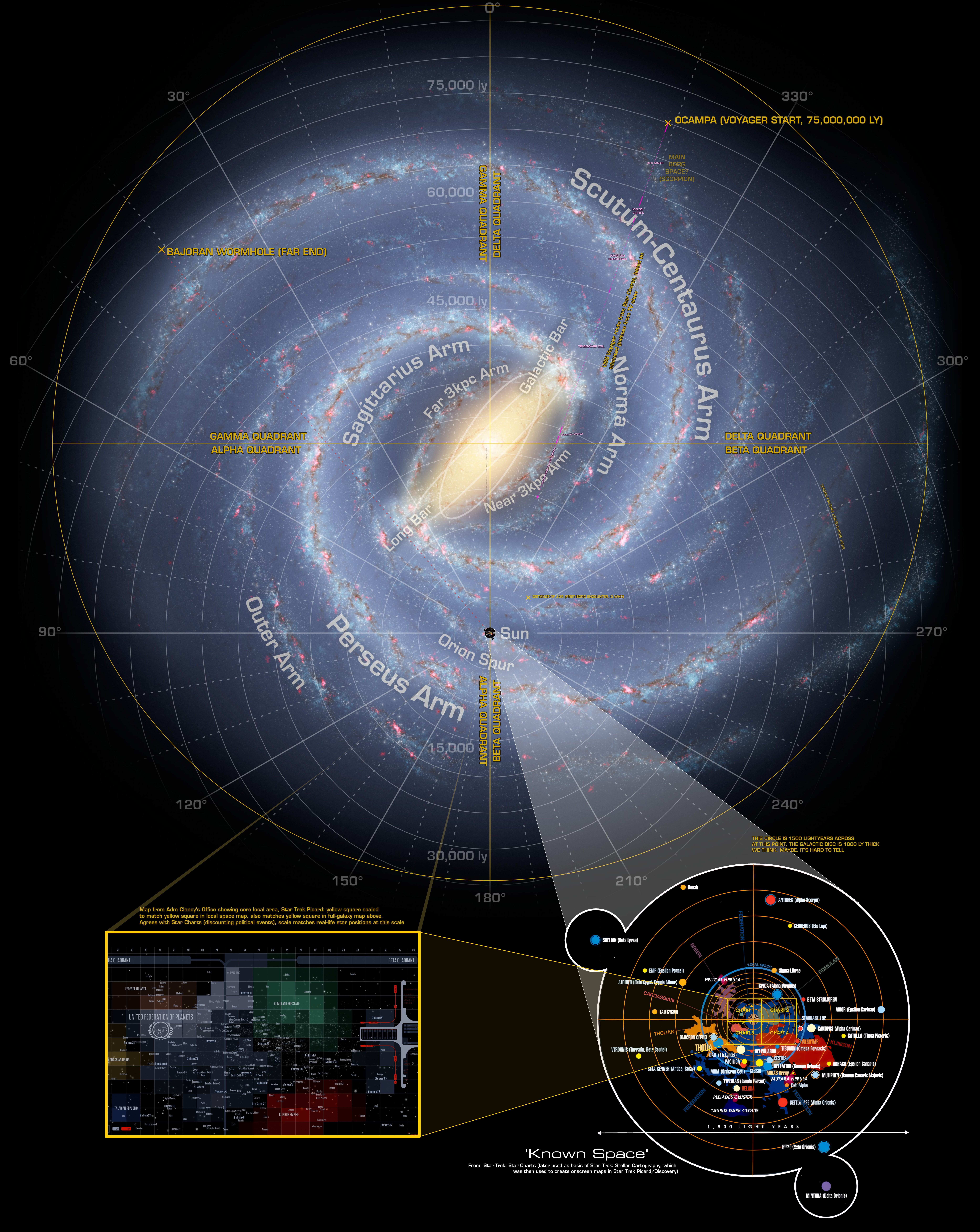
MWG top-down map showing UFP/Starfleet location
–
Starfleet Hotties:
As always, I (Auz) fucked and made love with every single sexy female in this organization, just as I do all sexy females everywhere and every-when, this being the nature of the Omni-verse, all of them desiring to please me more than anything, and feeling more satisfied and complete by contact with me than anything. Since they do not have superhuman/goddess powers, what it unlocked in them is their full potential as explorers and science officers/personnel. This is The Way.
–
Ground Vehicles:
–
2023 September/+:
Starfleet shields are so powerful they can easily take many/indefinite direct nuclear hits, as they are designed for the much higher energies encountered during warp.
Even antimatter bombs, such as photon torpedoes (each with an explosive force a degree of magnitude greater than that of the biggest thermonuclear weapons of 21st-century ETW), can be withstood by Starfleet shields. In fact, the Constitution-class in this fleet/organization can take 90-photon-torpedo barrages 5 times in a row before its shields are compromised/ended.
…
…
2245 A.D. was the start of the first Enterprise
Max safe warp 6; 392x light speed (LS)
2363 A.D. was the start of Enterprise D
Max safe warp 9.2; >1,516LS
all warp speeds explained, etc.
The relationship between warp factor and multiples of light speed is not logarithmic (in the popular image of a Starfleet officer viewing it on one of their Bridge screens), it’s cubic –but because they chose a logarithmic scale for the multiples of light speed, the graph is that of 3 ln(w).
…
How many years was an Enterprise D deployment?
4 years
Total years Enterprise D was in service:
8
How often was it at warp?
often just at the start and end of a mission/episode
Avg. speed of the earlier Enterprise/s:
10 LY/day
Total distance covered by the Enterprise D:
>2,700,000 LY, including all the way out to the far side of the Triangulum galaxy, due to The Traveler making that unexpected jump possible, thereby severely skewing its data/avg.; without that jump, in its 8 years it would only cover ~a thousand LY (~250/yr).
How far did it travel in LY during 1 deployment (under normal conditions)?
hundreds of LY; nowhere near across the MWG, let alone outside it
Where is its gravity generated?
A generator powers gravity-plating throughout the interior.
Reference
…
Star Trek: Discovery, while yet another blatantly corrupt brainwashing and propaganda attempt by the humanimal Outlanders / Jewlywood, still has a somewhat-interesting concept in it.
Setting: ~1 decade before the famous NCC-1701 (first Enterprise) ship –that number meaning it is the 1st produced of type 17.
…
The ship featured in Star Trek: Discovery has the number 1032; 32nd produced of type 10.
It is clearly another retrofit not that unlike the TR-3B; it is an inefficient shape/system built around an only partially-understood/-harnessed tech’/principle, a prototype through and through.
…
attempted explanation / theory
…
Basically Discovery is teleporting not just 1 person to a ship, but the entire ship anywhere the spores-network is.
This is still primitive, by Inisfreean standards, b/c it is highly complicated, risky, etc..
…
Deployments are based on ship class/type; smaller/older ships deployed for months at a time, like how submarines stay underwater that long, while the largest ships deployed for several years at a time.
…
They see Space as empty ish, and stars as too hot to approach, never thinking of attempting communication and teamwork with either, and they spend almost all their time in darkness, not just during travel, but under their clothes, isolated in so many ways.
While warping Space seems clever, and Trans-warp and Hyperspace and Quantum Slipstream seem even more clever, all are still as backward-minded as airplanes and automobiles made to require depletable fuel to fight against nature; why do that when you can use natural forces and situations for the power source, and when you can skip distance/Space almost entirely –via the stars, portals, and so on?
…
Regarding Inertial Dampeners / Damping:
In the ’09 film, Sulu gets chided for forgetting to release the “external inertial dampers”, which prevents them going to warp. It’s supposed to be like having a parking brake on, but why? What purpose would it serve? We know (internal) inertial dampers keep everyone inside from turning to soup at high-warp speeds, but what use would there be for such things externally? And if they serve a similar function, would it not make more sense to engage them at warp? Or are they supposed to be like retro rockets or something?
Surely it seems like the writers don’t understand the term and just threw it in, but how do we make sense of it in terms of the reality of the film?
…
Without inertial dampeners in space, the momentum of a shuttle docking with a ship could send the ship (slowly) careening off into a wall. This is especially a threat in spacedock.
They also allow you to easily kill velocity. In real space, orbiting earth, you must be traveling exactly as fast in exactly the same direction to rendezvous with another vessel. This requires you to fire rockets to move towards the target and fire rockets the opposite direction to stop (kill relative velocity). This still usually leaves some velocity vectors (drifting random directions) that we currently fix with little bursts of gas.
With external inertial dampeners that’s not a problem. You don’t have to turn the ship and exert thrust to stop and you don’t have to use kinetic projections to completely stop.
Now for warp, in order for internal inertial dampeners to have any meaning for warp there must be some kind of acceleration. If it were just creating a bubble and going, there would be no movement on the ship. So the ship needs to move through regular space before it warps, meaning that an external dampener would get in the way.
…
I imagine a layer of compressed space-time around the ship that acts like external airbags (or like the car foam in Demolition man) to keep ships from smashing into a melted sheet of metal when they crash onto planet surfaces.
If it is a warping of space-time or subspace along the ship’s hull, even if it allows the ship to accelerate to impulse speeds, it might interfere with the creation of a stable warp field.
…
Full impulse was listed as ¼ of the speed of light (.25c), which is 167,000,000 mph or 74,770 km/s.
The impulse engines have a required acceleration of 10 kilometers per second per second, which is just over a thousand G’s.
…
By “The Next Generation”, Starfleet had charted (not controlled) 11% of the MWG.
–
Also see:
- the walk-through of a computer-game recreation of the entire Enterprise here.
- “Star Trek: The Evolution of the USS Enterprise”
- Star Trek Enterprise-D tour in 4K (stage 9)
–
